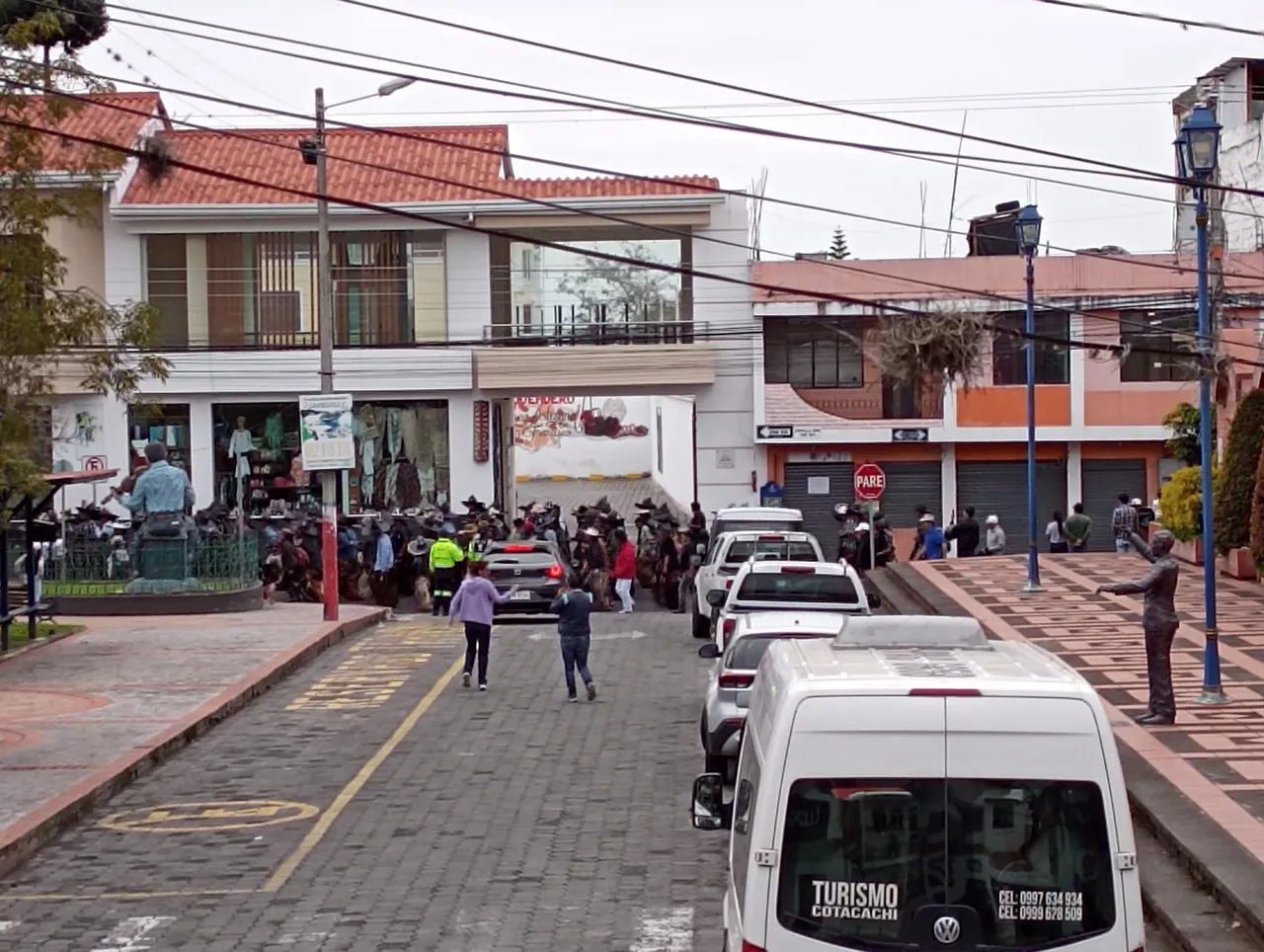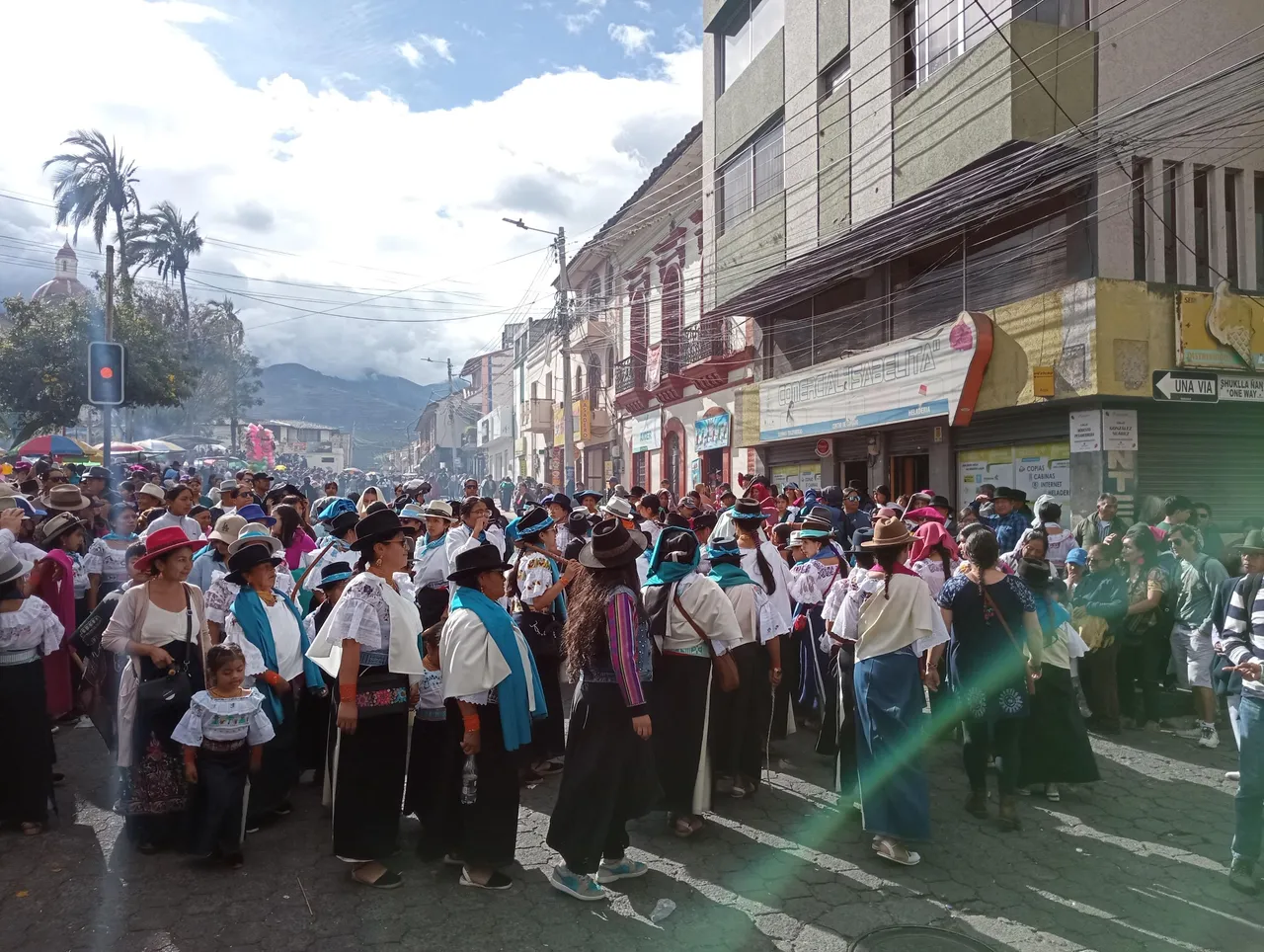As my post about the Inti Raymi in Zuleta was getting very, very long, I decided to break it up and separate the Cotacachi part, as it's more than enough for a post in and of itself. Hope you enjoy it!
Get in line!
As I mentioned in my previous Inti Raymi post, there are a lot of diferences between how Inti Raymi is celebrated in the communities. In Cotacachi, the groups come dancing from their communities into town in order to re-take the main square, a kind of re-conquista, taking back what was theirs and stolen by the Spaniards. Due to many challenges, the order has been changed over the last years, to guarantee more safety for everyone.
The first line is usually a couple of cops warning the cars to get to the sides and hold still until the group passes.

The second line are women from the community, wives and daughters, elected as known by everyone, so they have some authority before the men who easily fall in trance (with or without alcohol) and are not easy to be hold in organization. Hurting a woman in public is not well seen, so this line does help. They sometimes dance backwards, facing the group.

The third line are the musicians, playing the same tunes over and over, keeping the group in their communal trance. Again, this is a line of safety.
The fourth line are one or two captains that run up and down the line in order to keep the group in check and the pace up.
This is not the same in every community. Most of those lines are implemented as reactions to accidents and aggressiveness in the last years. The communities try to make this event as peaceful as possible, though trenched with strong and a kind of energy that I often describe as "violent", not in the physical sense, but because of the aggressive nature and symbolism that the re-taking of the main square brings with it.
In this video, you can see that they separate almost each line with by persons in the middle, running up and down the space.
... I can hear the stomps. They're coming.
Yes, you can hear them from far away. When I danced down the mountain with a far-up community in 2017, it was an impressive sensation to get into town. Suddenly, the sound of the stomping, shouting and music bounced back from the walls, multiplied. What was formerly absorbed by the dirt roads, covering us in dust, rose from the paved roads into a spectacular sound wall, silencing everything around us. Incredible.


Things in Cotacachi are different. It's usually not as colorful as Zuleta for example, but more uniformized - on purpose. You can see the black hats with symbols of oppressive powers, like the christian cross and the swastika (a lot of times turned sideways or not totally exact. The military jackets, too, are an appropriation of oppressor symbols.
You can also here the stomping, the whistling, the repetitive harmonica melody, some shouting and motivational "rap", and the sound of the "pututus" - huge shells of marine snails which are used trumpet-style.

Unfortunately, there is a quite a few of rivalries between some of the communities in Cotacachi. There have been heavy and bloody fights in the 11 years that I'm here, and the police has ever since tried to stop that. But it's not easy to stop a stomping, alcoholized and energized horde. Tear gas is used almost every year at least once - so this year. But only once this time, and the Municipio quickly stepped in and organized meetings between the police and the community leaders. The communication has improved a lot between the factions in the last years.

In total, the amount of fights is getting less. A lot less. Anyway, the city also installed new surveillance cameras everywhere in the city, part of their security plan. Cotacachi is very safe, especially in comparison to other parts of the country at the moment.
Wawa y Warmi Punlla!
The day of the women. Actually wawakuna and warmikuna punlla, as it's plural. Anyway. The first day is the day of the children, wawakuna. (Kichwa did never have a writing, so you'll be able to find many different spellings of these words.)
I personally enjoy the Wawakuna Punlla a lot, as Lily's school usually organizes to go there together, with all the kids. This year, that didn't take place, but here's a picture from one of the last times.

My second favorite day is the Warmikuna Punlla. It's much more colorful than the "men's" dancing days, and has much more melody in it. Not really like Zuleta, but more into that direction.

The structure of the dancing is the same, musicians in the middle, everyone circling around. And if you think that the women don't drink, well, you're up for quite the surprise. But there's a lot less tendency to violence that day, and it's usually the day that most photographers come to take pictures.
There are some men among them, but usually just walking next to them, doing what usually the women do - carry the food and other things. Police is present, too, but much less in personal than the other days. There's not much need for them, luckily.

There is also a tendency to reduce the amount of mestizo-people participating during all of the festivities. If you want to dance, you have to be invited by the community. Before, mestizos (the word for people with more Spanish than indigenous genes) were always getting into the groups, sometimes quite drunk, not seldom being the cause for fights breaking out. Based on that, the communities are becoming stricter on who they admit among their ranks, and the Municipio and the Police support them.

A lot of people here don't understand much of the significance in the culture, especially the mestizos. They understand it superficially, know a thing or the other, but there is no deep comprehension (that includes myself, as a foreigner it's even harder). They take it as an excuse to get wasted and stir some trouble. Fortunately, there seems to be a growing amount of people within the communities that are researching and educating, finding the roots of their traditions, and hence fortifying the correlated values in the community.
The celebrations are an important part of regaining control over the narrative about their own culture. It's not my culture, but I do hope and root for them to keep up and grow that confidence over the next years. It has become very rare that traditions and cultures are being strengthened instead of being weakened by individualism.
Thank you very much for reading! I hope you enjoyed this kind-of-second part about the Inti Raymi festivities in Ecuador. I can highly recommend visiting during this time, even for spectators without further knowledge it's a marvel for the eyes. And no, Ecuador is not as dangerous as displayed. Just be as cautious as always on your travels, inform yourself about no-go areas and use common sense.


